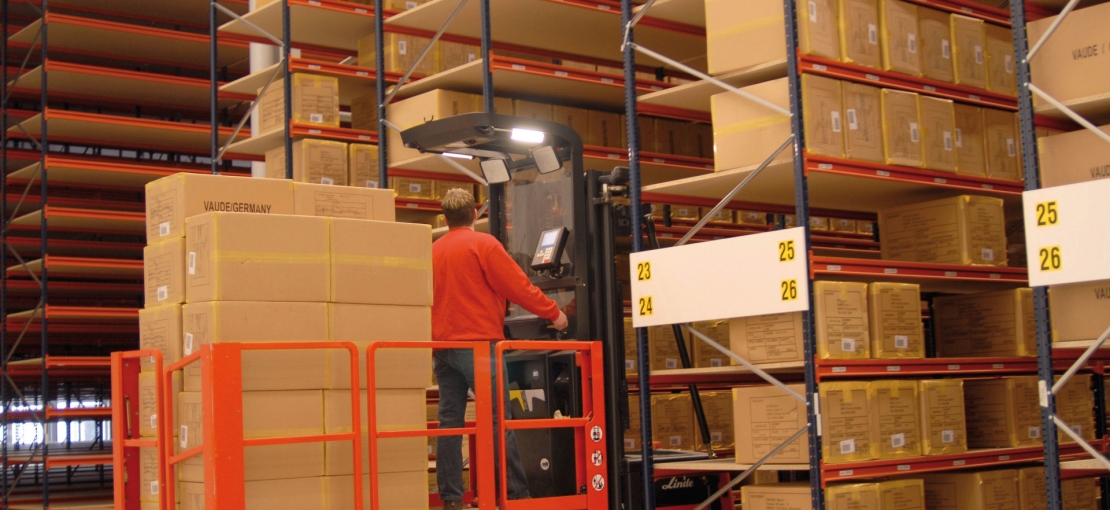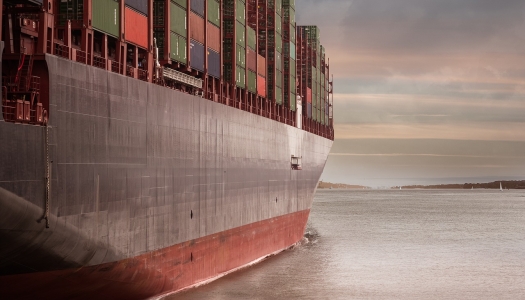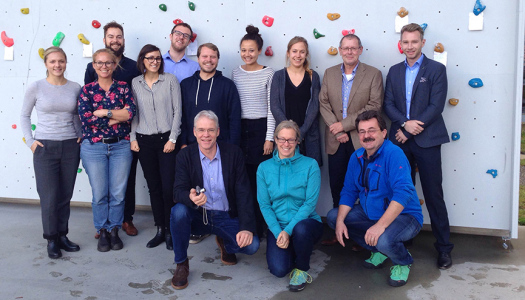
Halfway around the world – yet still eco-friendly?
Green logistics research project reveals potential for optimization
We live and work in a globalized world. Before reaching customers, our products travel long distances. We’ve long been aware that this generates emissions, even though the greatest percentage of our products by far travel the longest distances by container ship and rail.
We have examined where changes can be made to reduce transport emissions and how to set these changes in motion in a Green Logistics Project.

|
Arrival by ship
Ship transport produces very few emissions per ton of freight, even when the voyage goes halfway around the world. |
Environmentally friendly transport by ship
VAUDE products are primarily transported by large container ship and by train from their production facilities to our warehouse. This type of transport is responsible for a very low amount of emissions per individual product.
The results of our research project have confirmed that sea freight also contributes significantly to environmental pollution and that we cannot just sit back and relax with our current merchandise logistics.
Eight students from the interdisciplinary course of study, Risk Assessment and Sustainability Management (RASUM), at the Technical University Darmstadt dealt with the issue of how VAUDE can optimize its transport in order to reduce emissions over a period of several months.
Emissions per ton of freight
Create your own infographicsLow transport emissions per product
This graphic presents the various delivery scenarios of emissions per ton of freight. Calculations were made by the non-profit organization myclimate. It is clear that based on the weight of an individual product, ocean freight is only a tiny fraction per ton of freight. Once products are flown, however, emissions are high.
Approximately half of all VAUDE emissions come from logistics
The VAUDE Carbon Footprint is the foundation for the Green Logistics Project. All relevant logistics data has been collected annually since 2011 by our partner shipping companies and flows into the annual VAUDE Carbon Footprint. Read more here.
The research group examined the transport routes of VAUDE products to VAUDE in light of ecological, economic and social aspects:
1. Which logistics options are available now and which will be available in the future?
2. What is the potential for reducing emissions of merchandise logistics?
3. What strategies and measures can VAUDE implement to achieve this?

|
Hard work with exciting results:
The RASUM student group of the Darmstadt University of Applied Sciences with Prof. Führ, the logistics service provider Group7, VAUDE Logistics Manager Uwe Abraham and Hilke Patzwall, Senior CSR Manager at VAUDE. |
Hilke Patzwall, Senior CSR Manager at VAUDE, reports on the research project:
Specifically, the students dealt with the following sub-projects:
- Flow of merchandise analysis Asia
- Options for relocating production sites
- Alternative transport routes, i.e. through Triest vs. Hamburg
- Ecological evaluation of various transport options
- Comparison of rail vs. air freight from Asia
- Direct delivery to customers
- Collaboration options
- Funding
Climate compensation based on the implementation of measures
Working together with the experts of the Group7 logistics company and its scientific network and supported by their professor Martin Führ, the students used the data and facts provided by VAUDE to develop eleven recommendations on how we can reduce logistics emissions.
These include measures that can be quickly implemented and we will introduce at least some of them, for example, rail transport through Asia instead of airfreight and participation in logistics networks.
Other measures are more complex to implement and will have a serious impact on our processes. We are integrating these measures into our company goals and budget allocation so that we can tackle them step by step. It will be helpful for us to soon launch a new merchandise management system in which we want to map significantly more data in order to be able to control processes and decisions better with less manual effort.
As soon as we have significantly reduced the emissions from the transport of goods, we plan to include the transport emissions in our climate compensation.
Transport routes of VAUDE products
Upstream and downstream transport arises primarily from the delivery of goods commissioned by VAUDE to the warehouse in Obereisenbach as well as their delivery to our customers.
VAUDE products cover three major stages of transport:
• Transport of components and materials to the producers
• Transport of products from producer to VAUDE
• Transport of products to the customer from VAUDE
In addition, emissions are caused by the delivery of all consumables required in Obereisenbach for our onsite production of bags and for the remaining company divisions: materials, buckles, packaging materials, building materials for the workshop, paper, furniture, coffee, etc.
The Green Logistics Project examines the route of products from producers to VAUDE.
How are materials transported to VAUDE?
We do not have any impact on the transport of materials from various upstream suppliers to our apparel manufacturers. Generally speaking, even though we designate which materials they should use, we do not buy them ourselves. Read more here. By sensitizing our producers to environmental issues, we want to raise their awareness of transport emissions.
Deliveries from our producers to VAUDE
The majority of the products are transported by ship from Asian producers to Hamburg. From the port of Hamburg, the products travel to Ulm by rail and are then delivered to Obereisenbach by truck.
From an ecological perspective, transport by ship and rail makes the most sense.
Whenever it is possible in light of customs legalities and organizational considerations, goods are delivered directly from producer to our major customers or to the recipient country without a detour into our warehouse, for example, to our customers within Asia - see also Our Markets.
Avoiding airfreight
We try to avoid airfreight from producers to VAUDE – the costs alone are reason enough for this. Sometimes, however, we have no other choice in order to deliver goods on time to our customers.
When producers are responsible for the time constraints, they need to cover the costs of airfreight, which means that these figures are not included in the VAUDE Carbon Footprint.
How products are transported from VAUDE to retailers
The processes in our own warehouse in Tettnang-Obereisenbach have already been largely optimized by state-of-the-art technology. The dispatch from the central warehouse in Obereisenbach to our customers (specialist dealers) is pack volume optimized and collected by truck - first with fully loaded container units to the shipping company hub, then by truck to the respective region, and only the last 20 kilometers by courier vehicle.
Our shipping partners themselves highly value climate protection and are continuing to develop further in this area.
| GRI: | 302-1 |
| GRI: | 302-2 |
| GRI: | 302-3 |
| GRI: | 302-4 |
| GRI: | 302-5 |
| GRI: | 305-3 |




